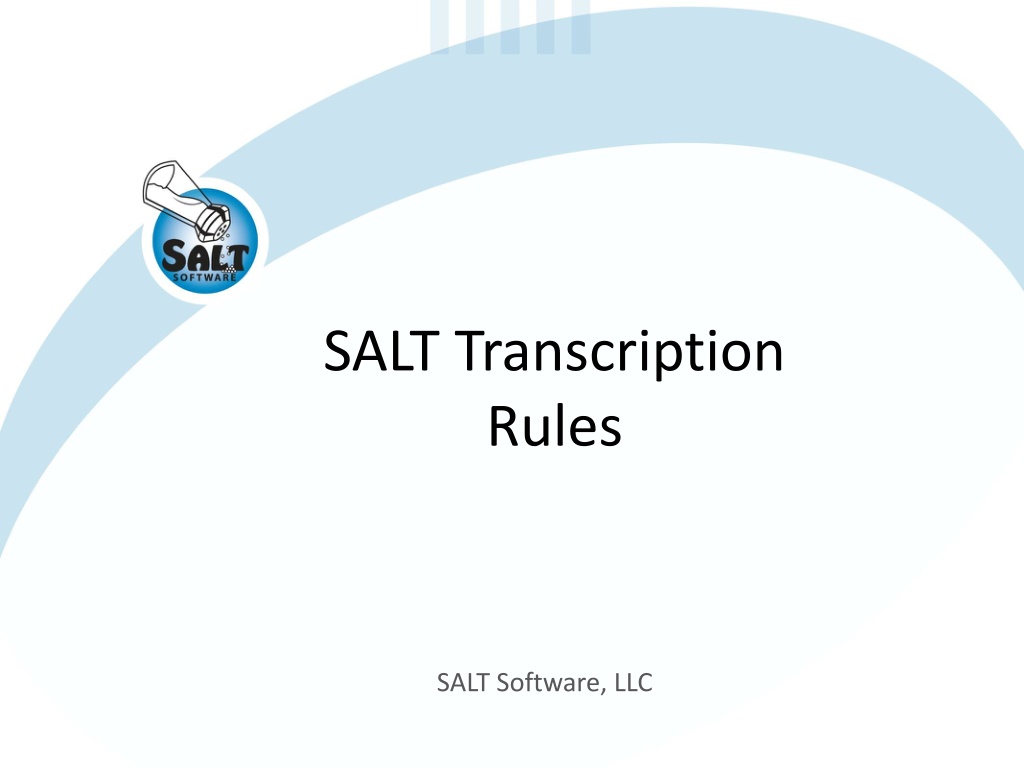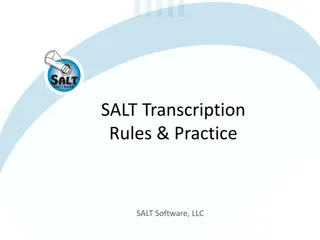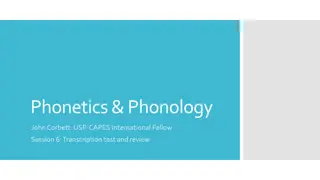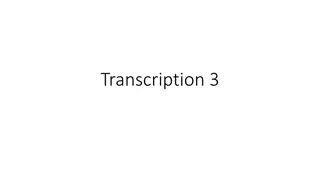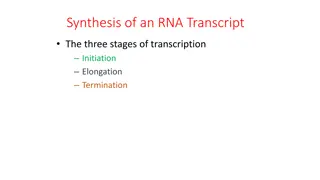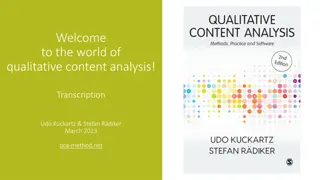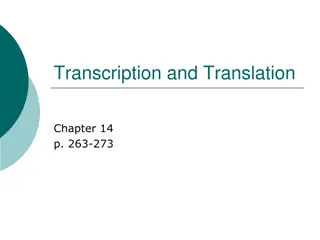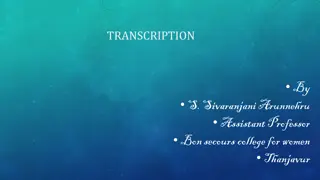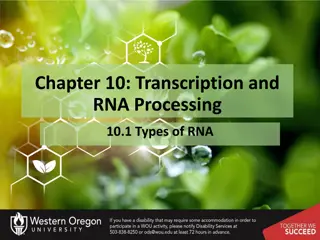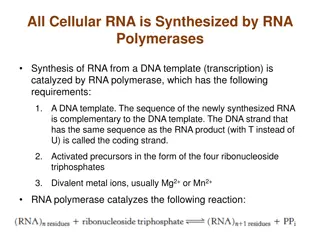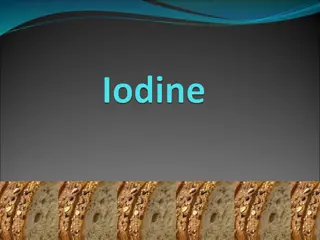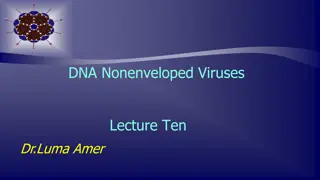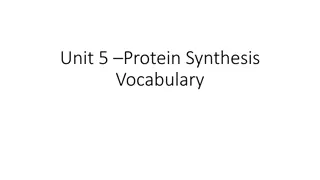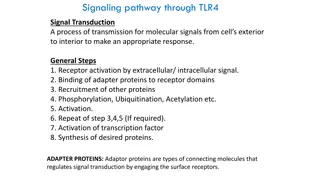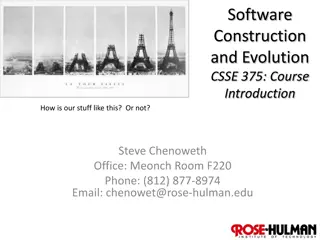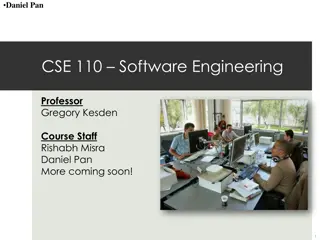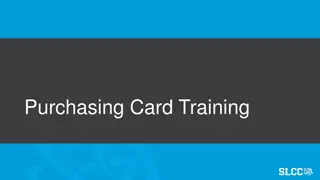Guidelines for Accurate Transcription in SALT Software
Detailed information on the transcription rules, processes, and resources provided by SALT Software for accurate transcription. Includes guidelines for transcribing, segmenting clauses, analyzing transcripts, and importance of accuracy in transcription. Valuable resources and training tools available for users to enhance transcription skills.
Download Presentation

Please find below an Image/Link to download the presentation.
The content on the website is provided AS IS for your information and personal use only. It may not be sold, licensed, or shared on other websites without obtaining consent from the author. Download presentation by click this link. If you encounter any issues during the download, it is possible that the publisher has removed the file from their server.
E N D
Presentation Transcript
SALT Transcription Rules SALT Software, LLC
LSA Process Record a language sample Transcribe the sample Analyze the transcript Interpret the results
Importance of Accurate Transcription These are real people. The analysis of the transcript can help inform decisions about services. If the transcript is not accurate, the results may be misleading.
Transcription Keys Transcribe verbatim Use SALT coding conventions Speakers say things we find difficult to transcribe 95% should be easy to transcribe 5% will be difficult
SALT Transcription Rules: Handout Contents A. C-Unit utterance segmentation B. Transcript format C. Bound morphemes D. Spelling conventions E. Parenthetical Remarks F. Unintelligibility G. Mazes (filled pauses, repetitions, revisions) H. Overlapping speech and interjections I. Pauses (unfilled) J. Omissions and errors
Transcription Resources Reference documents found at http://saltsoftware.com/resources/tranaids Summary of Transcription Conventions Summary of C-unit Segmentation Rules Free online classes found at http://saltsoftware.com/training/self-paced-online-training 1300: Transcription Quick Start 1301: Transcription Getting Starting 1302: Transcription Transcript Format 1303: Transcription Utterance Segmentation 1304 1306: Transcription Conventions 1308: Transcription Practice Samples Help built into the SALT software F1 key for context-specific help (transcription conventions while in editor) Resources accessible from the Help menu
Transcription Rules p. 2 C- Unit Segmentation an independent clause and its modifiers One main clause, with all dependent/subordinate clauses attached to it Coordinating Conjunctions (signals to segment into new C-unit) and, but, or, and then, then, so (not so that ) Subordinating Conjunctions (do not segment into new C-unit) because, that ( that may also be an implied subordinator), when, who, after, before, so that, which, although, if, unless, while, as, how, until, as__as, like, where The canarywas perched on a branch when the manapproached him. Anastasiawas angry with her mother because shedidn t get to buya toy. Main Clause Subordinate Clause When the boylooked around his bedroomthe froghad disappeared. Subordinate Clause Main Clause Subordinate clauses cannot stand alone or are incomplete without the main clause
Transcription Rules p. 2-3 Transcript Format Line identifiers $ identifies speakers + header information C or E or other speaker identifiers = transcriber comments : or ; between-utterance pauses - timing lines
Transcription Rules p. 2-3 Transcript Format Ending punctuation Mandatory Final character in every utterance Quotes and codes must precede end punctuation Punctuation marks Statements end with a period or exclamation point . ! Questions end with ? wh , y/n, rising intonation Abandoned utterances end with > Interrupted utterances end with ^ Intonation prompts end with ~
Transcription Rules p. 2-3 Transcript Format Timing lines Mark beginning and ending time SALT uses timing lines to calculate elapsed time and speaking rate Begin timing lines with a hyphen Format time in elapsed time or clock time hours:minutes:seconds minutes:seconds :seconds Example: - 0:34 { initial time in minutes:seconds } . - 5:14 { final time in minutes:seconds }
Transcription Rules p. 2-3 Transcript Format Transcriber Comments Comment lines Begin line with an equal sign followed by the comment Comment within utterances Enclosed within braces Examples = child consistently refers to Doctor DeSoto as Doctor Doto C {child nods}.
Bound Morphemes Marked to give speaker credit for using specific morphology Allows for accurate calculation of mean length of utterance in morphemes (MLUm) C He/ s go/ing to the zoo. MLUm = 7 Allows for accurate count of number of different word roots look, look/ing, look/3s, look/ed
Transcription Rules p. 3 Plurals (/s) and Possessives (/z) /s for plural, e.g., dog/s Do not mark plurals if there s no singular form, e.g., news, tidings Do not mark irregular forms, e.g., mice, wolves, deer, geese /z for possessive, e.g., Mary/z car Do not mark possessive pronouns, e.g., mine, his, hers, its, ours, yours, theirs /s/z for plural possessive, e.g., baby/s/z names
Transcription Rules p. 3-4 Verb Inflections Present Progressive (/ing) /ING for present progressive, e.g., they are look/ing Do not mark gerunds, e.g., we enjoy watching the birds Present Progressive Gerunds End in ing End in ing Function as verbs Function as nouns Follow an auxiliary be verb Rarely follow the auxiliary be verb Are marked as bound morphemes Are not marked as bound morphemes
Transcription Rules p. 4 Verb Inflections Regular Past Tense (/ed) /ED for regular past tense, e.g., look/ed, stop/ed, try/ed Do not mark irregular past tense verbs, e.g., were, saw, went, had, made Do not mark past participles, passive forms, and predicate adjectives, e.g., She was tired. The store was robbed. The grape/s became shriveled.
Transcription Rules p. 4 Verb Inflections 3rd Person Singular (/3s) /3S for 3rd person singular, e.g., she run/3s Do not mark irregular forms, e.g., has, was Do not mark if the sound of the root changes, e.g., do does
Transcription Rules p. 4 Verb Inflections Past Participle (/en) /EN for past participle, e.g., take/en, eat/en, prove/en Do not mark irregular forms, e.g., gotten, spoken, seen, been Do not mark forms if the sound of the root changes, e.g., write written Hint: regular form is present tense + EN as a separate syllable. /EN verbs always follow a HAVE verb.
Transcription Rules p. 4 Contractions / T, /N T for negatives If the sound of the root does not change, mark the negative did did/n t can can/ t If the sound of the root changes, do not mark the negative do don t will won t Why? It is believed that when the sound of the root changes, children learn the negative form as a different word rather than a variation of the same word.
Transcription Rules p. 4 Contractions / LL for contracted will / M for contracted am / D for contracted would / RE for contracted are / S for contracted is / VE for contracted have Examples: they/ ll, I/ m, she/ d, we/ re, he/ s, we/ ve
Transcription Rules p. 4 Contractions /H S for contracted has /H D for contracted had /D S for contracted does /D D for contracted did / US for contracted us Examples: He/h s been sick. We/h d better go. What/d s he do for a living? Why/d d he leave? Let/ us go.
Why are some bound morphemes marked and other not? For a discussion see SALT blog posted 12/2018. https://saltsoftware.com/blog/why-do-we-mark- some-bound-morphemes-and-not-others/ This same discussion is included in the SALT Reference book at the end of Appendix M. This book is accessible from the SALT 20 Help menu.
Transcription Rules p. 5-6 Spelling Conventions Abbreviations: Do not use a period to abbreviate words, e.g., Wed, Sept Yes words: ok, aha, mhm, uhhuh, yeah, yep, yes No words: no, ahah, mhmh, uhuh, nah, nope Hyphenated words follow standard spelling conventions, e.g., mother-in-law, pick-me-up. Numbers and dates Transcribe as a single word, use written form or digits e.g., twenty-one, 21, May_1_2002, 5-1-2002 Clock time: Do not use colons when transcribing clock time because colons will be interpreted as pause times. Type out the words connected with an underscore, e.g., eight_thirty, five_oclock
Transcription Rules p. 5-6 Spelling Conventions Counting and spelled words use the underscore to connect the numbers or letters, e.g., 1_2_3_4_5, C_A_T Concatenatives are transcribed as single words betcha, coulda, gonna, gotta, hafta, liketa, lookit, musta, oughta, outta, shoulda, sposta, trynta, useta, wanna, whatcha, woulda Other shortened words e.g., cuz because OR cuz|because ya you OR ya|you Proper names and titles Joined together using the underscore, e.g., Mr_Smith Idiosyncratic forms Consistent, stable productions, not adult-like Begin with a percent sign, e.g., %vroom (recognized by listener as car )
Transcription Rules p. 5-6 Spelling Conventions Sound effects Essential to the meaning of the utterance: begin with a percent sign, link multiple sounds, e.g., %woof_woof, %vroom Not essential to the meaning of the utterance: enter as a comment Sounds with specific meanings hmm, huh, IDK, uhoh, shh or %shh, psst or %psst Other spellings ain t, a lot, atta, no one, oh, ooh, oops, oopsy
Transcription Rules p. 6 Parenthetical Remarks Word or clause added by speaker as explanation, comment, or request for help Enter within double parentheses Occurring within utterance Does not contribute to the meaning of the utterance e.g., C So Sam ((I think his name is Sam)) left the house. C Then the boy ((what/ s his name)) < > left the house. E <Sam>. Stand-alone utterance Does not contribute to the sample; exclude from most analyses e.g., C ((I skipped a page)). C ((Do I have to tell the whole story))?
Transcription Rules p. 6 Unintelligibility Listen three times X = one word unintelligible XX = partial utterance unintelligible XXX = entire utterance unintelligible $ Child, Examr E Where/'s the dog go/ing? C Go XX now. E Did you see the airplane? C X X up X. C XXX.
Transcription Rules p. 7 Mazes (filled pauses, repetitions, revisions) Filled pauses (AH, EH, ER, HM, UH, UM, [FP]) List of recognized filled pause words can be edited in SALT Use [FP] to code nonstandard filled pause words, e.g., like[FP], you_know[FP] Part-words Mark with an asterisk, e.g., b*, st* Stuttering in the middle of a word Separate the beginning and ending sections of the word with underscore characters, e.g., ele_ (ph*) _phant Repetitions or revisions/reformulations Maze the initial occurrences of a repetition or revision. Do not end an utterance with a repetition or revision unless abandoned or interrupted. Combine adjacent mazes
Transcription Rules p. 7 Overlapping Speech and Interjections Linear transcription Preserve the target speaker s utterance Use < > to mark overlapping segments E What was the next thing <you did>? C <I did/n t> do anything else. Mark interrupted (^) utterances C The boy :02 <look/ed>^ E <What did> the boy do? Use empty < > to mark the location of another speaker s interjections/interruptions within the utterance. C The boy < > look/ed for the frog :02 <in the> pond. E <Uhhuh> . E <I see>.
Transcription Rules p. 8 Pauses (unfilled) Mark significant pauses (2 seconds or longer) Pauses within utterances Format time in seconds, e.g., :03 or :3 Include pauses adjacent to mazes as part of the maze Example: C The movie :02 was (um :05) Batman. Pauses between utterances Format time in seconds or minutes:seconds Pause occurs between utterances of different speakers Begin pause line with a colon Pause occurs between utterances of same speakers Begin pause line with a semicolon (typically) Begin pause line with a colon if you want to force a turn change Examples: :04 ; :04 : 1:05
Transcription Rules p. 8-10 Omissions and Errors Omissions Omitted words begin with an asterisk C Daddy went *to the store. Omitted bound morphemes begin with an asterisk C Daddy went to two store/*s. Omitted contractions: words vs bound morphemes C She *is leave/ing now. OR C She/* s leave/ing now.
Transcription Rules p. 8-10 Omissions and Errors Errors Overgeneralizations = [EO] C Daddy goed|go[EO:went] to the store. Pronoun errors = [EP] C And so them[EP:they] left. Other word errors = [EW] C A[EW:an] owl scare/ed the boy. C The boy is a[EW] sleep/ing. Utterance level errors = [EU] Errors not associated with specific word C And he got stuck his head [EU]. Utterances with more than two omissions and/or word errors; to avoid over-correction C And the dog lick/*ed the boy to thankhim to[EW:for] be/*ing so nice. BECOMES C And the dog lickthe boy to thankhim to beso nice [EU].
Transcription Rules p. 8-10 Omissions and Errors When NOT to mark omissions and errors Don t hold speaker to grammatically perfect language Consider if appropriate for speaker s age and the sampling context Use the does it sting your ear test
SALT Transcription Rules SALT Software, LLC
